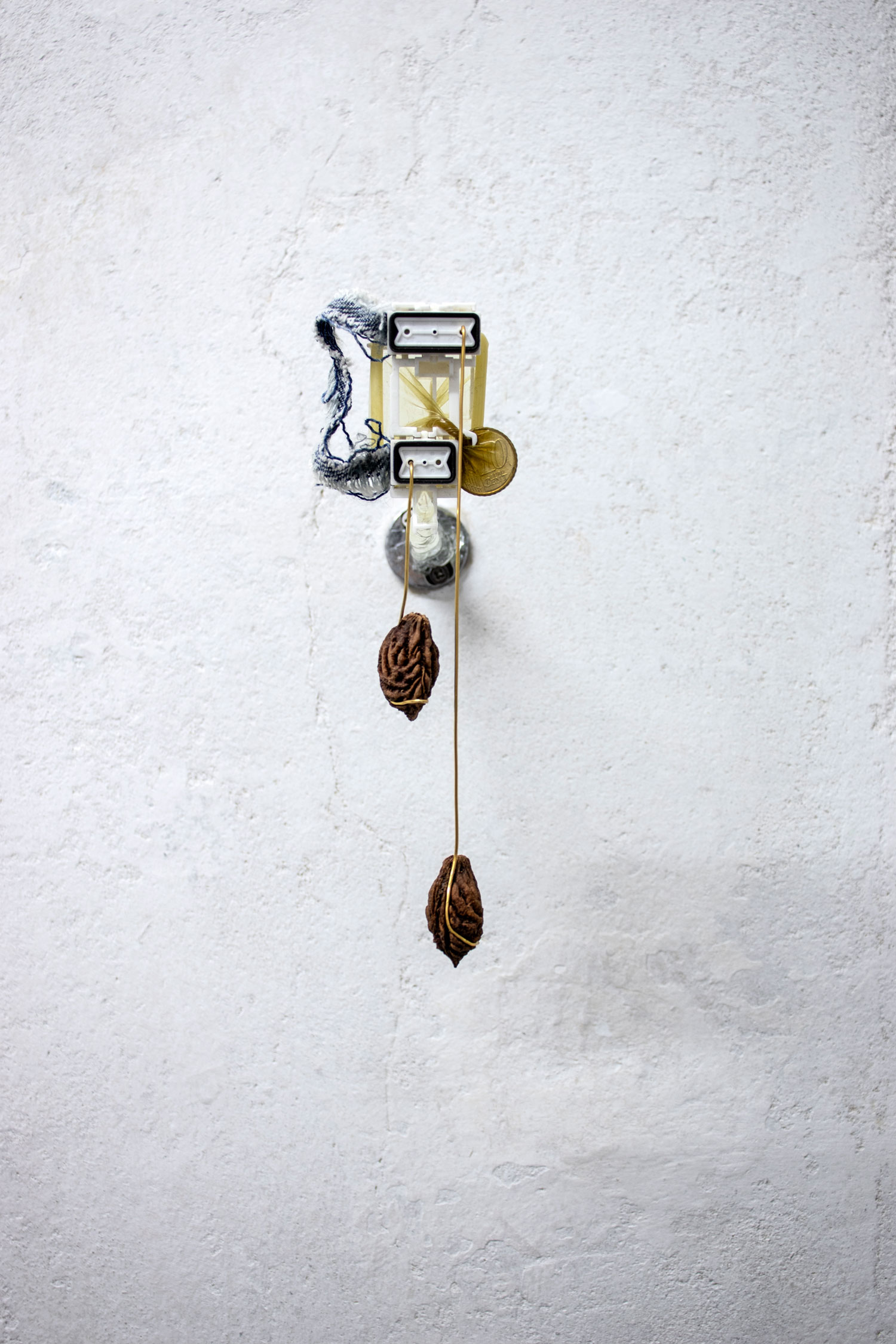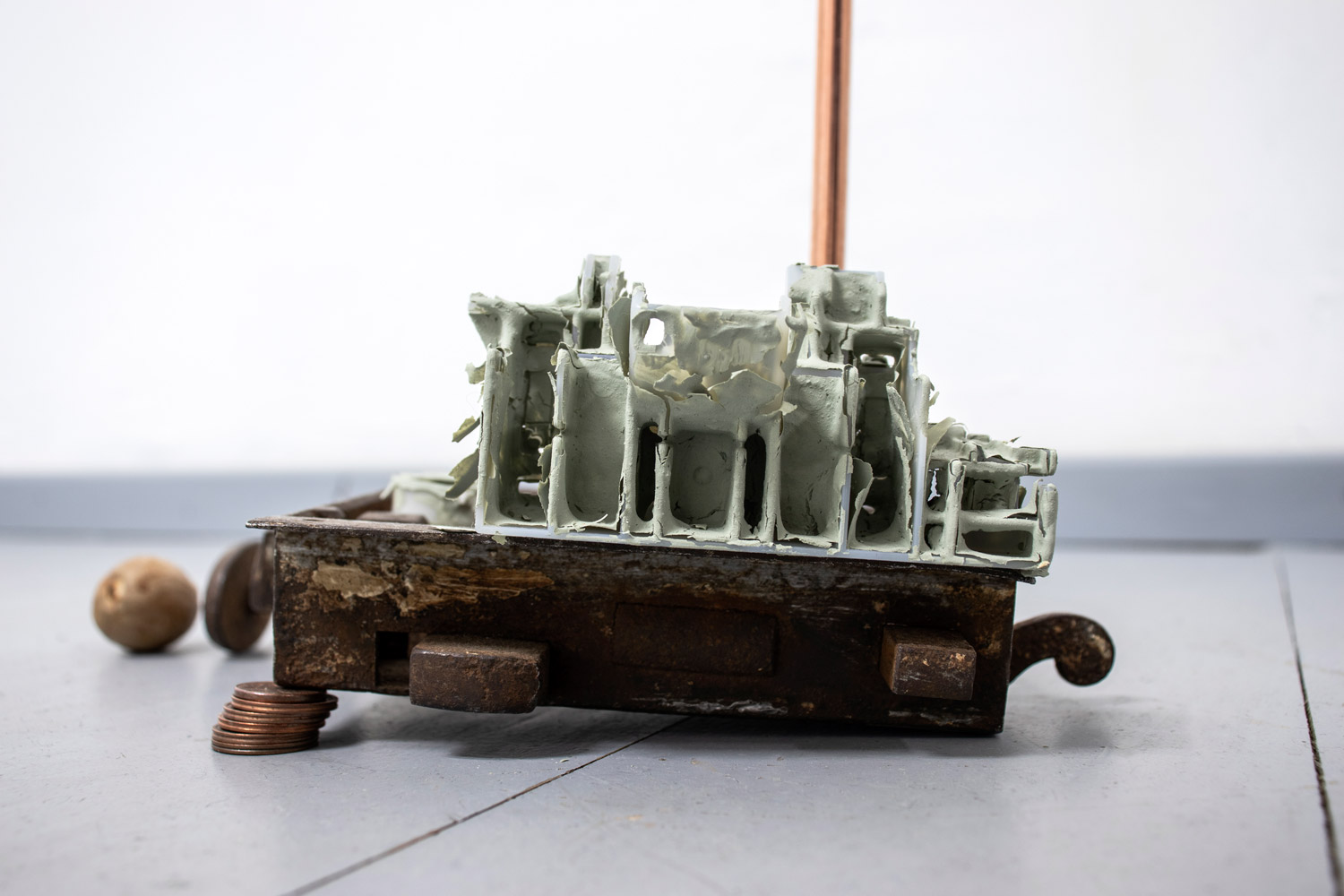The Nameless Healer
Exhibition text
“That people could come into the world in a place they could not at first even name […] and that out of a nameless place they could grow and move around in it until its name they knew and called with love, and call it HOME, and put roots there and love others there; so that whenever they left this place they would sing homesick songs about it and write poems of yearning for it, like a lover…” – William Goyen, The House of Breath, 1950
When we think of a home, we imagine a delineated geometrical space, an architectural typology that designates shelter. And yet, the home is composed of a complex emotional and juridical landscape in which affect and legality intertwine. It is a space that perpetuates intimacy at times, conflict at others. This complex nature of the home can be considered as the oikos, an ancient Greek term simultaneously signifying the home, the economy of the home, and the family. This shifting meaning of the oikos is contradictory, and it is precisely this paradox between the political-economic and affective realities of the domestic space that lies at the heart of Antonin Giroud-Delorme’s work.
Unfolding across an enfilade of rooms, “The Nameless Healer: Prologue” addresses notions of kinship, representation, and the body within the domestic sphere. In a blending of organic and inorganic matter through various sculptural gestures, Antonin Giroud-Delorme gives shape to this domestic body, fragmented and ever changing. “Kinship networks tend to be reduced to a bare minimum; domestic life is being poisoned by the gangrene of mass-media consumption; family and married life are frequently “ossified” by a sort of standardization of behavior,” wrote Félix Guattari.[1] This standardization has ritualized conduct, particularly expressed through the body, discipling the family through a radical transformation in its becoming nuclear.[2] This has led to a certain fragmentation that Giroud-Delorme questions while considering the transcendence of such delineated spaces and systems through mystical and symbolic relational powers. For Giroud-Delorme, the tensions between the affective and the administrative are at the heart of the myth making of the home and its nuclear family.
Crossing the threshold between the exterior and interior space, we enter the antechamber– the transitional space traditionally functioning as a final barrier between the home and outdoor world– and confront a series of wall sculptures (Regional Manifestation series). Scanner beds housing various objects of everyday life take on the form of blazons as they bear marks typical of heraldic traditions. Protruding from the edges of each blazon are teeth or horns modeled in wax as the objects morph into ritualistic masks. At once devices in establishing territory and vignettes of still life scenes, these sculptures present images derived from the everyday raising questions of both collective and personal identities. Through an overlapping of histories and memories, an intersectionality of beliefs is materialized in a complex visual language. From dried plants to pendants; from a snail shell to hair, the objects evoke gestures of daily domestic rituals, like that of putting on a necklace, or the brushing of one’s hair.
These daily rituals are further emphasized by the installation and sound intervention by Tim Karbon. In the center of the room floats a carillon made up of symbols that are activated by Tim Karbon as he layers various sounds recorded while in residency with Antonin Giroud-Delorme resulting in a triad of sound. Filling the space is the drone of machines, followed by an exaggerated humming, a closing door, the clinging of kitchen utensils, and other hardly recognizable yet familiar noises, as a reminder that our domestic spheres are never truly silent; that the sonic dimension of the interior space is corporeal and omnipresent.
This corporeality of the interior space manifests itself in the installation The Nameless Healer. A cluster of sculptures representing a fragmented being embodies at once the home and its inhabitant. For Antonin Giroud-Delorme, this environment is not only livable but alive, creating a network of affect and energy. “If matter itself is lively, then not only is the difference between subjects and objects minimized, but the status of the shared materiality of all things is elevated […] And in a knotted world of vibrant matter, to harm one section of the web may very well be to harm oneself.”[3] This consideration of matter as vibrant is thus conducive to healing and care.
At the core of the installation is a coconut shell filled with a vibrant purple liquid. This vessel– a metaphor for generosity, a generative source, the body itself– becomes the nucleus of this nameless healer, from which stem various extremities made up of elements derived from the interior world. An old, dysfunctional lock rests on the floor, supported by a stack of coins, becoming the roots for a tree-like form made up of copper and a bramble, bearing three small hearts that float amongst the thorny branches. At the foot of the sculpture are the dismantled guts of a printer, dipped in green clay, evoking images of architectural models in ruins. This extremity represents the desire for both private property and security of the home. Next to this, a cast of a brain from which unraveling jeans dangle sits atop a copper bar, portraying the central nervous system of the home. This fragment recalls the intimate relationship between human and object, suggesting the moment when user and object become one– like jeans, a second skin. Another lobe of the brain appears next to a dismantled nightstand that stands erect, simultaneously embodying the protector and protected. Wrapped around the phalanges of this entity are bandages and thimbles as a reminder of this healing presence. The drawer from the nightstand lies on the floor in the distance. Drawers reveal the intimate potential of matter as they are amongst the various “hiding places in which human beings, great dreamers of locks, keep or hide their secrets,” within the home.[4] In this drawer, an image of a family record book (livret de famille) printed on a translucent sheet extracted from a computer flirts with dried tulips and coins– the oikos materialized. With this installation, the inhabited space transcends geometrical space through affect, and the inhabited body transcends itself, becoming disorganized matter, dispersed throughout the space. This dispersion reflects the various infrastructures that depend on more than their own bodies, and the need for symbiotic relationships.
From this expansive and morphing entity, we move to a more private and enclosed space of secrecy in the final room of the exhibition where various microcosms of the home space are represented. Projecting from the wall are amulets hanging from strands of the artist’s hair dripped in resin in the series LexEstQuodNotamus. “The law is what we write.” A ring, the symbol of a legal contract binding two individuals; a key, referencing private property; condoms, a reminder of intimacy and sexuality; a malfunctional computer hard drive, recalling how kinship mutates with the development of technology; dried plants, peach pits, and fish bones, like small momento mori– this material reverie considers matter within a complex web of affect and legality, entrusting each element with the mystical power of protection.
The healing process is complex, counterintuitive, and restrictive– like the domestic space. Yet, the binary separation of the inside from the outside, of the body from space, must be reconsidered in order to move beyond the constructed and “collective perspective of homeness.” [5] Antonin Giroud-Delorme challenges these constructs through the material narratives he presents here.
“My house is diaphanous, but it is not of glass. It is more of the nature of vapor. Its walls contract and expand as I desire. At times I draw them close about me like a protective armor… But at others, I let the walls of my house blossom out in their own space, which is infinitely extensible.”[6] With the reverberation of the sound, the fragmented body, and dispersion of affect and matter throughout the space, the corpus of the home becomes infinitely extensible, defying the physical and juridical limitations of domestic life.
Katia Porro
[2] Tomas Maldonado and John Cullars, “The Idea of comfort,” Design Issues, Vol. 8, No. 1, 1991, p. 36.
[3] Jane Bennet, Vibrant Matter, Durham, Duke University Press, 2000, p. 13
[4] Gaston Bachelard, The Poetics of Space, Boston, Beacon Press, 1992, p. 74.
[5] Alina Popa,“The Second Body and the Multiple Outside,” Unsorcery, Bucharest, Punch, p 144.
[6] George Spyridakis, Mort lucide, 1953.

